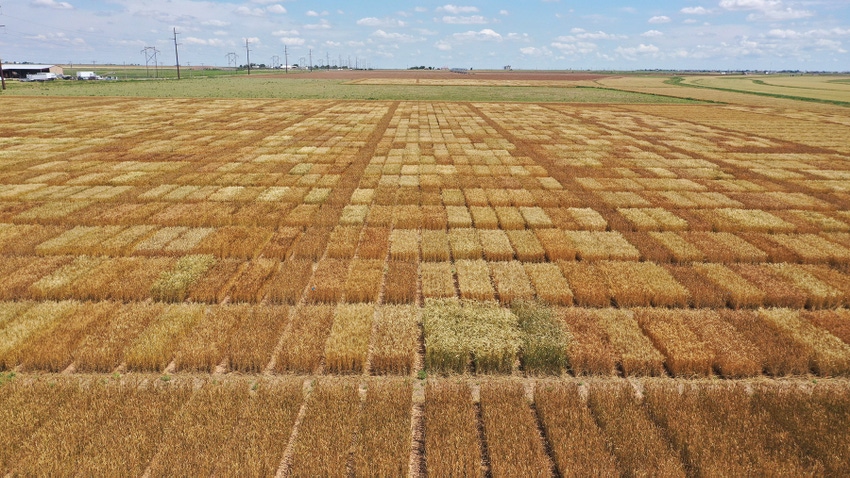
The first place to look when choosing a wheat variety for Texas grain production should be the “Picks List,” an annual publication of varieties evaluators “would choose to include and emphasize on our farm for wheat grain production.”
The varieties that make that list come with a minimum three-year performance and variety characteristics data, says Texas A&M AgriLife Extension Agronomist Calvin Trostle, Lubbock.
“A variety in the Pick List is not necessarily the top yielding variety,” Trostle says.
The following criteria are also considered:
Milling and baking quality
Important disease resistance traits (leaf or stripe rust, wheat streak mosaic virus)
Insect resistance (greenbugs, wheat curl mite, and Hessian fly)
Standability
“These important varietal traits enable a producer to better manage potential risk,” Trostle says.
He adds that the three years of data is an important consideration. “That means in the High Plains, where we have quite a few more trials than in other regions of the state, three years could represent 12 irrigated sites over a three-year period. For dryland, that could be 15 sites or just eight or nine, depending on drought that year.”
Trostle explains that former Extension Agronomist Brent Bean started the Picks varieties concept more than 20 years ago. “It began only for the High Plains. After he stepped aside about 10 years ago, I and other colleagues expanded to include other regions across the state.
“I think the list now brings a bit more explanation to the criteria. I remember suggesting that if I were a farmer, these are the varieties I would include on my farm. I think that helped farmers understand the Pick List.”
He adds that the list is not a “recommendation. We chose not to use the word recommended. Our Pick varieties gives producers some clarity.”
He explains that the list is based on “pages and pages of data. If we put all of this data on the web, even in just one document, that would be a lot for a farmer to sort through.”
Key traits
Pick evaluators consider key traits that help producers focus on varieties that perform better. Three of those key traits in the High Plains are resistance to leaf rust, stripe rust, and wheat streak mosaic virus.
“For growers in the Rolling Plains, Hessian fly tolerance is important. So, we have varieties on our Pick List for that region that have that tolerance. They perform well but are included in great part because of Hessian fly tolerance, which is a difficult issue to control in wheat. We don't have Hessian fly here in the Texas High Plains.”
Trostle says he doesn’t discourage farmers from planting a variety they really like. “There's no reason not to continue to plant a favorite but we encourage them to get maybe six bags (which would plant four or five acres) of one of these other Pick varieties just to compare.
“Perhaps compare a variety without leaf rust resistance with an appropriate Pick that does have leaf rust resistance.’
He said several factors could play roles. “It could be a year where leaf rust becomes an issue, so you might have something in the field that makes a noteworthy difference. The farmer should recognize that the variety with leaf rust resistance may not need to be sprayed.”
Few surprises
Trostle says few surprises arise on the Pick List from year to year. “The Pick List does not change much from one year to the next.
“If we get a surprise from a variety, it's usually on the negative side. Possibly, a variety that has performed well for a number of years suddenly and consistently across several locations did not perform well. That would raise a yellow flag, and we would put that variety on a watch list.”
He says drop in performance could occur because “something changed and we don't recognize why it's not performing as well. It could have been just an exceptional or unusual combination of environmental factors.”
He says varieties are dropped from the Pick List over time.
“Varieties are removed usually for one of two reasons. Either performance has dropped off or a better alternative becomes available that is a stronger choice.”
Trostle says about half the Pick varieties are not Texas A&M lines but adds that Pick evaluators typically have more data available on A&M lines. “We are able to test those while they are still experimental.”
For more information on Texas wheat varieties see https://varietytesting.tamu.edu/wheat/[CT1]
Seed availability
Trostle says, despite a challenging growing season, overall wheat seed availability should be adequate. “I have only in the past six weeks or so of tight seed supplies for only a few varieties. The harvest would suggest there could be some issues, but all the seed production is irrigated. A few areas where irrigated wheat didn't do that well, but in other areas it did very well.”
He recommends, however, that farmers who want a specific variety should check sources early and have two or three backup varieties if preferred ones are not readily available.
Read more about:
Seed VarietiesAbout the Author(s)
You May Also Like






